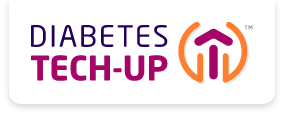Well connected: How CGMs can help introduce patients to other diabetes tech tools
By Diana Isaacs, PharmD, BCPS, BCACP, BC-ADM, CDCES and Natalie Bellini, DNP, FNP-BC, BC-ADM, CDCES
10 min read

For any individual with diabetes, their needs can change over time. Their comfort level with technology may grow as well. Clinicians can go beyond helping patients start on diabetes tech—they can help them explore tech options and develop their self-management potential.
We reached out to Diana Isaacs and Natalie Bellini, cohosts of the podcast Diabetes Dialogue: Technology, Therapeutics, and Real-World Perspectives. They’ve been helping people with diabetes navigate self-management technology for decades. Diana and Natalie received fees from Novo Nordisk for their participation.
Here’s what they had to say about the clinician’s role in introducing patients to diabetes tech and building from there.
What do you see as the most helpful types of entry-level technology for people with diabetes?

I'd say continuous glucose monitors (CGMs) top the list. We’ve been giving people blood glucose meters (BGMs) since the early 1980s, but today it’s common to prescribe CGMs to people with type 1 diabetes.1,2 Thanks to updated Medicare and commercial insurance coverages, people with type 2 diabetes can also start on CGMs as soon as they’re prescribed insulin.3
I think the CGM is ideal as entry-level tech because behavioral learning tools can help most people after they’re diagnosed with diabetes. When are they having highs and lows? Where do they need help? A CGM can help them pinpoint the behaviors that may be causing these trouble spots.4
One of my goals when I prescribe a CGM may be to delay the need for medications whenever it is possible. I’d rather start with behavior change and see how far that gets us before bringing meds into the equation.

The great thing about starting patients with a CGM is they can see the continuous rise and fall of glucose throughout the day. What happens when they go for a walk? What if they eat an apple instead of drinking apple juice? With a CGM they can see their glucose excursions hour by hour, minute by minute, and draw initial conclusions about their behavior.4
Once they’ve worn the CGM for a week or two, we usually have lots to talk about. I’ve seen some people who wear a CGM and check it on their own, but they don’t share the CGM data with their health care team. It may be saving them some finger sticks and helping them learn about their habits, which is good, but they can get so much more from it by discussing the data with their health care professional.4
For that person who swaps out juice for a whole apple, we can talk about what happened to their blood sugar. We can discuss how the whole apple has fiber and how fiber may lead to a smaller excursion from their target range.5
It’s one thing for us to tell people what foods can make their glucose spike—but, in my experience, when the CGM lets them see it for themselves, it can really help them take action and make that change.

How can a CGM help open the door to other diabetes tech?

For someone who takes insulin, a CGM can be a natural gateway to insulin delivery tech. The CGM supplies the clinician with glucose data, which can prompt changes in insulin dosing.4
Say I have a patient who’s supposed to take bolus insulin injections 3 times a day, but isn’t doing it as consistently as they think. If I prescribe them a connected “smart” pen, it gives them a digital log of insulin doses to look at along with their CGM data. They can see how their insulin affects their glucose, and then we can use that data to refine their insulin dosing.6 It’s a symbiotic, balanced relationship between the devices.
The CGM may also show them times of day when a change in the insulin dose could help. If they want the ability to adjust their insulin for certain situations, or if they want to be able to set temporary basal targets, they could consider an insulin pump or automated insulin delivery (AID) system.7,8
I’ve also seen the smart pen-CGM pairing become a gateway tool for people who initially didn’t want to use an insulin pump. I think the smart pen may help them get comfortable with digital recordkeeping, and the CGM can get them used to digital glucose monitoring. From there, it may be a more manageable step to switch to an insulin pump or AID. For some people, that kind of incremental approach may help.
Of course, plenty of people don’t want to wear anything on their body at all, so a smart pen may suit them for the long term. Although I rarely see people using a smart pen without a CGM. For most people, I think it makes sense to use them together.

It’s one thing for us to tell people what foods can make their glucose spike—but, in my experience, when the CGM lets them see it for themselves, it can really help them take action and make that change.

And for someone who doesn’t even want to wear a CGM, there are options for other types of entry-level tech, like a BGM that can upload readings to the cloud.9
The patient using this cloud-connected meter can upload their readings and call me to say, “Can you look at my glucose? My fasting readings are going up and I’m not sure why.” If I can look at their glucose readings online, I’d prefer that to calling them back with no data and asking them to pull out their meter so they can read me the memory.
Who knows, maybe that cloud-connected meter could be the entry point for a tech novice to try other diabetes tech later on…

Using a CGM together with a diabetes app, an insulin pump, or a connected insulin pen may help people gain more dynamic insights about their diabetes than using these tools alone.
What other types of diabetes tech can a CGM help unlock?

The other type of tech that can pair naturally with a CGM is a diabetes management app. Apps can help newly diagnosed people digitally track their glucose, insulin, and food intake. Both apps and CGMs are tools that may help with lifestyle changes.10
When people get a CGM, they usually start with the app that comes with it. From there, I’ve seen a lot of people branch out into diabetes apps that can do a broader range of things. I think the most helpful diabetes apps are versatile—they allow people to integrate glucose levels from their CGM with multiple types of data: food, insulin, and physical activity.

I usually encourage people to shop around for apps with features they like. Some apps have a dosing calculator that you can connect to a CGM. Some apps with meal tracking features let you take photos of foods and integrate the nutrition information with CGM data.10
I also love the potential for social connection through diabetes apps. People who may have felt alone or isolated in trying to manage their condition can use an app to involve their family, their friends, or other people with diabetes.
Looking at CGM data in an app may help them talk to their loved ones about it and bring them in for support.4 I’ve seen people use apps to share food insights and make fitness plans with other people in their households.
Some apps give people access to message boards that let them talk with other members of the diabetes community. Features like that may help people feel like they’re not living alone with their diagnosis.

I think the most helpful diabetes apps are versatile—they allow people to integrate glucose levels from their CGM with multiple types of data: food, insulin, and physical activity.
How quickly do you see people make changes after they start on a CGM?

I see a lot of people make significant changes to their physical activity and food choices within a few weeks or months after starting on a CGM.

So do I. I think about one woman with type 2 diabetes who came to me because she needed knee surgery, but her A1C was too high for the procedure. She was discouraged; getting to an A1C under 7% seemed so far away, and she didn’t want to wait too long for the surgery.
I suggested that a CGM would be a good way to identify when she was having highs, and that might help her figure out where to start. I was expecting to see a modest reduction in A1C initially, and I guessed that the next step might be to titrate up her insulin.
When she came back after 3 months of wearing the CGM, I was amazed to learn that she had actually been experiencing some lows. She had used the CGM and its app to guide her in replacing high-carb foods, and she had also discovered that going walking helped to keep her blood sugar from spiking after meals.
She was thrilled that the CGM helped her change her eating and activity habits to reduce her A1C. Pretty soon, she was able to get the knee surgery. To my surprise, we were also able to reduce her insulin in the long run.
How do you identify what type of entry-level technology is right for any given patient?

Once we’ve established their treatment and self-management needs, I try to find out what aspect of the user experience is most important to them. Is it user-friendliness? Is it customizability? Is it support from the manufacturer?
Most often, people have a vague idea of what they want from the tech, but they need some guidance in picking it out. I like to walk people through several options to find a type of tech that suits their comfort level.

Absolutely, comfort level is so important, especially with wearable tech. Diabetes is a marathon. Whatever type of tech people use, they may need to be comfortable with it for a long time.
I make a point of checking in at every visit to ask how they’re feeling about their current device, even if they’ve been using it for a while. I try to stay open to reevaluating someone’s plan, even if things are going well. After all, new technologies are emerging all the time, so people’s options can change. It’s my job to stay up to date and offer them choices based on what’s available.11
For example, it’s possible that a patient of mine might have been comfortable with a pump for years, but if they switch to an insulin regimen that requires less frequent dosing, would they still feel it’s worth it to do all the maintenance that goes with the pump? They may be open to exploring an option that didn’t exist before.

New technologies are emerging all the time, so people’s options can change. It’s my job to stay up to date and offer them choices based on what’s available.
How do you try to set people up for success when they’re starting on diabetes tech?

People starting out with a CGM often need help with the physical aspects. If I can sit with them and show them how to put the sensor on, that helps them get comfortable.
Some of my patients have come in intimidated, imagining the CGM as a bulky device that would bother them throughout the day. Most of them have been pleasantly surprised when they realize how small the sensor really is.
Once they put it on and experience how it really feels, then they’re ready to start looking for ways it can help.

One challenge I’ve seen when introducing people to tech is to set realistic expectations—both for them and the clinician. We have to keep in mind that diabetes tech is a tool, not a cure. Most patients aren’t going to hit all their glucose targets right away.
When a person with type 2 diabetes starts on a CGM, I try to set expectations for incremental changes to their current A1C. The CGM doesn’t innately know any individual’s time in range (TIR) goals, so I like to set alarms for them based on realistic targets. For someone just starting out, it can be frustrating to hear alert after alert when you’re not even used to wearing the sensor yet.
After the initial setup and training, how do you help troubleshoot and provide ongoing support?

After people have used tech for a short time, they usually come back with questions. That makes sense—we don’t want to overwhelm them with every detail about a device on the first day.
The first session, we give people enough information to get them started. In later sessions, we follow up and help them individualize their devices, like setting their own custom alerts.4

We also check in about how they’re doing with the physical wear of CGMs.4 Does the tape itch? Does it fall off? If so, what soap do they use? We try to help them with common issues at the outset, and then we tailor our support to them over time.
This is especially important when we think about a CGM as a gateway to other tech. We want to make sure they’ve gotten comfortable with the CGM before we start giving them other devices. Building skills with multiple types of tech can take a little time. That’s okay. Like we said, it’s a marathon.
The follow-up help doesn’t have to come from just the primary care provider. It may be a nurse practitioner, a physician assistant, or a pharmacist who helps troubleshoot; everyone on the health care team can contribute to building the patient’s knowledge and capabilities.

I strongly recommend that every primary care provider identify and build a relationship with a certified diabetes care and education specialist (CDCES).
Adding a CDCES to the diabetes care team can help patients get their questions answered and sharpen their tech skills in between primary care visits.4 Find a CDCES at a local diabetes self-management education and support program and refer patients who are starting on diabetes tech.
How can you tell when a person with diabetes is doing well with their tech?

Diana and I tend to see people with T2D who have been putting off treatment and lifestyle changes for a while. Even if their glucose is elevated, it may not hurt. Changing their self-management may seem like too much work considering how they feel.
When these people start on entry-level tech, we hope they realize that it can help drive their behavior in a positive direction. As they change their lifestyle, they may see a change in their numbers, and I think that may help motivate them to keep using the CGM.
For that person who used to be struggling or in denial, the feeling of making progress may be a strong motivator. If I see that after a few months of wearing a CGM they feel empowered to keep using it, keep modifying their habits and lifestyle, and even add other types of tech to their routine, then I know it’s had a big impact.
This is a hard condition to live with day after day, and it can lead to a feeling of “it’s never done.” So I love it when a person with diabetes can use tech to get some relief from the grind. If using a CGM with an app helps them feel like they can go out with friends, get exercise, and be able to handle their blood sugar while they’re doing it, that can be satisfying for us all.
Tech-up Follow-ups
- Think about patients you know who have had success with multiple types of tech. How did they handle the transition from their entry-level tech to a more complex routine?
- Identify one patient currently using a CGM who you think might be ready to add another type of tech to their treatment. Discuss this possibility with them at your next visit.
- Make a note to ask one patient how they feel about the tech they’re currently using. See if they express any interest in making a change.

Diana Isaacs, PharmD, BCPS, BCACP, BC-ADM, CDCES
Cleveland, Ohio
Diana is a diabetes pharmacist and diabetes advocate. She works as the Director of Education and Training in Diabetes Technology at the Cleveland Clinic and serves on the Board of Directors of the Association of Diabetes Care and Education Specialists (ADCES). She cohosts the podcast Diabetes Dialogue: Technology, Therapeutics, and Real-World Perspectives with Natalie Bellini.

Natalie Bellini, DNP, FNP-BC, BC-ADM, CDCES
Cleveland, Ohio
Natalie is an Assistant Professor of Medicine at Case Western Reserve University, endocrine nurse practitioner, and diabetes advocate who also lives with type 1 diabetes. She works as the Program Director of Diabetes Technology at University Hospitals in Cleveland, Ohio. She cohosts the podcast Diabetes Dialogue: Technology, Therapeutics, and Real-World Perspectives with Diana Isaacs.
Both contributors received a fee from Novo Nordisk for their participation.
–— Recommended for you –—

ARTICLE
Creating "aha!" moments: 3 ways I use diabetes tech to help patients overcome self-management barriers
Get tips for using diabetes data to help patients build knowledge, discover motivation, and draw connections between their actions and their glucose levels.
By Alicia Shelly, MD, FACP | 6 min read
References
- Hirsch IB, Battelino T, Peters AL, Chamberlain JJ, Aleppo G, Bergenstal RM. American Diabetes Association. Role of Continuous Glucose Monitoring in Diabetes Treatment. 2018. Accessed February 2024. https://www.ncbi.nlm.nih.gov/books/NBK538971
- ElSayed NA, Aleppo G, Aroda VR, et al. American Diabetes Association. 6. Glycemic targets: standards of care in diabetes—2023. Diabetes Care. 2023;46(Suppl.1):S97–S110. doi:10.2337/dc23-SDIS
- Moreau D. Final Medicare continuous glucose monitor (CGM) policy goes into effect April 16th. Danatech Diabetes Technology @ ADCES. April 7, 2023. Accessed March 2024. https://www.diabeteseducator.org/danatech/latest-news/danatech-latest-news/2023/04/07/final-medicare-continuous-glucose-monitor-(cgm)-policy-goes-into-effect-april-16th
- Association of Diabetes Care and Education Specialists, APhA. Personal Continuous Glucose Monitoring Implementation Playbook. 2020. Accessed March 2024. https://aphanet.pharmacist.com/sites/default/files/files/PERSONAL%20CGM%20PLAYBOOK%20-%20FINAL%20VERSION%201-13-2021.pdf
- Fiber: The carb that helps you manage diabetes. Centers for Disease Control and Prevention. Reviewed June 20, 2022. Accessed February 2024. https://www.cdc.gov/diabetes/library/features/role-of-fiber.html
- Sy SL, Munshi MM, Toschi E. Can smart pens help improve diabetes management? J Diabetes Sci Technol. 2022;16(3):628-634. doi:10.1177/1932296820965600
- Wilmot EG, Choudhary P, Grant P, Hammond P. Insulin pump therapy: a practical guide to optimising glycemic control. Pract Diabetes. 2014;31(3):121-125a. doi:10.1002/pdi.1846
- Phillip M, Nimri R, Bergenstal RM, et al. Consensus recommendations for the use of automated insulin delivery technologies in clinical practice. Endocr Rev. 2023;44(2)254-280. doi:10.1210/endrev/bnac022
- Grady M, Cameron H, Levy BL, Katz LB. Remote health consultations supported by a diabetes management web application with a new glucose meter demonstrates improved glycemic control. J Diabetes Sci Technol. 2016;10(3)737-743. doi:10.1177/1932296815622646
- Fu HNC, Wyman JF, Peden-McAlpine CJ, Draucker CB, Schleyer T, Adam TJ. App design features important for diabetes self-management as determined by the self-determination theory on motivation: content analysis of survey responses from adults requiring insulin therapy. JMIR Diabetes. 2023;24(8):e38592. doi:10.2196/38592
- Patil SP, Albanese-O’Neill A, Yehl K, Seley JJ, Hughes AS. Professional competencies for diabetes technology use in the care setting. Sci Diabetes Self Manag Care. 2022;48(5):437-445. doi:10.1177/26350106221120889
The Diabetes Tech-upTM Podcast
Join our expert cohosts for a series of discussions about how they’re integrating diabetes tech with patient-centered care to help optimize diabetes management.
The Mission of Diabetes Tech-upTM
Diabetes Tech-upTM is sponsored by Novo Nordisk, a global leader in diabetes. We believe that adoption of innovative technologies can help appropriate patients better manage diabetes. Our goal is to provide information to help health care professionals on the front line of diabetes care strengthen their understanding of diabetes technologies and implement them where they can have the greatest impact.



Share: